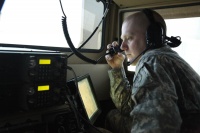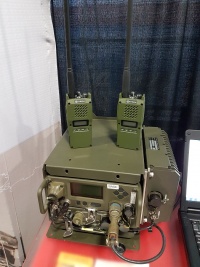SINCGARS
From HFUnderground
Single Channel Air-Ground Radio System, commonly known as SINCGARS "sink-gars", FM or Fox Mike radio. SINCGARS and FM are used in conjunction with HF-SSB systems, UHF/SHF/EHF SATCOM and other communications systems for military communications purposes.
VHF Tactical FM Land Mobile Air-Ground Military Communications
VHF-FM tactical radio system, with frequency-hopping and voice encryption/data encryption capabilities. Operating in the 30.000 to 87.975 MHz frequency band with 25 kHz channel steps. Uses 150.0 Hz CTCSS squelch system. Operates in single-channel (SC) and frequency-hopping (FH) modes for voice and data. Most radios include repeater capability (called RETRANS or retransmit in military usage). Compatible with previous-generation FM radios such as the PRC-25, PRC-77, PRC-1077, HH7700 and dozens of other similar tactical handheld, manpack and vehicle-mounted radios operating in the 30-76 MHz or 30-88 MHz range. NATO military forces and many other military forces use similar frequencies for tactical purposes, almost always with FM voice. The US military fields radios that operate in the 30-174 MHz and 30-512 MHz ranges to support SINCGARS, regular VHF-FM, 136-174 MHz VHF-high band services like VHF marine, aircraft radios, SATCOM and interoperability with other radio systems that use VHF/UHF.
In the United States, the military uses a combination of SINCGARS and VHF/UHF trunking systems for communications. The US government VHF-low bands are used in addition to the civilian bands on a non-interference basis. This includes use of the 50-54 MHz 6-meter amateur radio band and various portions of the VHF low band Business Radio frequency bands.
However, certain bands in the 30-50 MHz range (VHF low band) are allocated to exclusive government/military use. There are non-military government users of these frequencies, however most federal government agencies have moved to the 162-174 MHz and/or 406-420 MHz federal bands with the proliferation of trunking systems. There are still some wide-area networks such as the Tennessee Valley Authority's backup system that operates in the 40-42 MHz band.
Federal Government and Military Only Bands 30-50 MHz
This list applies to the United States only. The US military will often use frequencies outside these bands on a non-interference basis.
| Frequency Band |
|---|
| 30.000 MHz to 30.550 MHz |
| 32.000 MHz to 33.000 MHz |
| 34.000 MHz to 35.000 MHz |
| 36.000 MHz to 37.000 MHz |
| 38.000 MHz to 39.000 MHz |
| 40.000 MHz to 42.000 MHz |
| 46.600 MHz to 47.000 MHz |
| 49.600 MHz to 50.000 MHz |
It should be noted that military operations in single channel mode are found on any frequency between 30.000 and 87.975 MHz outside the government/military exclusive use bands on a non-interference basis. Use of the 150.0 Hz CTCSS or PL tone squelch allows for frequency sharing with other users, combined with the fact that civilian allocations in the 30-50 MHz band use 20 kHz channel steps, compared to the 25 kHz channeling used by military VHF-FM or SINCGARS systems.
Background and History
SINCGARS evolved from basic simplex and duplex military systems operating in the low to mid VHF range (30.00 to 75.95 MHz) starting with the revolutionary PRC-25 radio (using 150.0 Hz CTCSS squelch combined with channelization vs. "tuning" greatly simplified radio operation and made it easy for the average solider to use a radio with minimal training). The US military pioneered the use of FM voice on the battlefield in World War II with the original "three band" system, allocating 20 to 27.9 MHz to armor (100 kHz steps), 27 to 38.9 MHz to artillary (100 kHz steps) and 38 to 54.9 MHz to infantry (100 kHz steps). The famous BC-1000 or SCR-300 backpack radio fielded in WWII operated in the 40 to 48 MHz range using 200 kHz steps and FM voice. Tank radios with FM provided vast improvement over AM-based systems on the battlefield. Improvements with radio technology allowed for all three bands to be combined and moved from 20-55 MHz to 30-76 MHz and eventually 30-88 MHz, reducing channel spacing from 100 kHz to 50 kHz (Vietnam War) to 25 kHz (SINCGARS and present day). With the addition of frequency-hopping and voice encryption the FM radio became the standard battlefield tactical radio for ground and air communications.
This site is a participant in the Amazon Services LLC Associates Program, an affiliate advertising program designed to provide a means for sites to earn advertising fees by advertising and linking to Amazon.com. Some links may be affiliate links. We may get paid if you buy something or take an action after clicking one of these.

